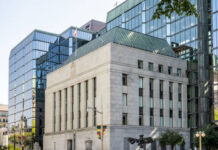Headlines
US stocks markets open around -0.75% lower as markets put in doubt the reflation trade following Friday evening’s political defeat. Losses on European stock markets are even slightly bigger, to the tune of 1%.
Confidence among German businesses (Ifo) beat forecasts to hit its highest level since 2011 in March. Ifo’s overall business climate index rose to 112.3 from last month’s 111.6. The gain was supported by improvements in the subindices for both current trading assessments and future expectations, which rose to 119.3 and 105.7 respectively.
Lending to euro zone households grew at its fastest pace since late 2010 last month (2.3%), but corporate lending unexpectedly slowed to 2% its lowest rate since June. The annual growth rate of EMU M3 money supply, which has in the past often predicted economic activity, rose 4.7% last month, from 4.8% and below 4.9% consensus.
South African President Jacob Zuma has instructed Finance Minister Pravin Gordhan to return immediately from an investor roadshow to Britain and the United States, the presidency said on Monday, without giving a reason for the decision. USD/ZAR rose from 12.3 to 12.65.
"To ensure price stability over the medium term, we must look through changes in headline inflation to the extent that they are transient," ECB Praet said in Madrid.
The UK’s largest banks face a review of consumer credit and their toughest ever test of resilience after the BoE unveiled an extra assessment of their ability to weather certain economic scenarios. The BoE will put the seven largest lenders through an additional examination alongside its regular annual stress test.
Rates
Reflation trade put in doubt
Global core bonds gained ground today. Failure to push the Republican healthcare bill through US Congress caused risk aversion this morning despite Friday evening’s tepid WS market reaction. Investors fear that Trump’s political defeat could signal problems ahead for his economic agenda. As a consequence, they put in doubt the reflation trade, sending stocks, yields, the dollar and commodities lower. At the time of writing, the German yield curve flattens with yield changes varying between +0.2 bps (2-yr) and -3.5 bps (30-yr). US yields decline between -2.9 bps (2-yr) and -6.1 bps (10-yr). The US 10-yr yield (2.35%) comes closer to key support (see graph; 2.3% lower bound sideways channel). On intra-EMU bond markets, 10-yr yield spread changes versus Germany are nearly unchanged with Portugal (-4 bps) and Greece (-9 bps) underperforming.
Intraday, the Bund opened higher, matching the overnight gains of US Treasuries after US House speaker Ryan pulled the health care vote because of a lack of support on Friday evening. Brent crude and stocks initially lost additional ground, sending the Bund and the US note future to an intraday high. European data included strong Ifo business confidence and mixed ECB lending data. However, as often, they failed to influence bond markets. ECB chief economist Praet reiterated that the ECB must look though the recent spike in (headline) inflation and hold on to the very substantial degree of monetary accommodation for underlying inflation pressures to build up. After the initial risk-off move, markets stabilised going into the US opening. As US investors entered dealings, sentiment soured again, underpinning core bonds. The US eco calendar is empty apart from a speech by Chicago Fed governor Evans who votes on policy this year. Last week he said that the Fed is on pace for two more rate hikes in 2017, in line with the median FOMC projection.
The US Treasury starts its end-of-month refinancing operation tonight with a $26B 2-yr Note auction. Currently, the WI trades around 1.25%. Tomorrow; the Treasury continues with a $34B 5-yr Note auction. On Wednesday, they conclude with a $13B 2-yr FRN auction and a $28B 7-yr Note auction.

Currencies
EUR/USD breaks beyond 1.0874 resistance
The correction on the reflation trade continued today. Especially US investors are disappointed on Friday’s failure to approve a new healthcare bill in in the House. They are selling equities and the dollar. EUR/USD cleared the 1.0829/74 resistance. The decline of USD/JPY was more modest compared to USD/EUR. Still USD/JPY nears the 110 big figure.
Overnight, US Treasury yields and the dollar declined. Regional equities ex Japan traded with, albeit modest, losses. The weaker dollar was a mixed factor for regional equities. USD/JPY took the lead in the USD decline. After a first initial downmove, the pair settled in tight range in the 110.25/50 area. So, the 111.60/39 range bottom was ‘really’ broken. The loss of the dollar against the euro was still more moderate at this stage. The pair traded in the mid 1.08 area. Even so, the test of the EUR/USD 1.0829/74 area had started.
Major European equity indices opened with losses of up to 0.75%/1%. Core bond yields extended the decline from the end of last week. Interest rate differentials narrowed again slightly in the disadvantage of the dollar. Initially, there were no further USD losses. EUR/USD stabilized in a tight range near 1.0874 resistance. USD/JPY hovered in the lower half of the 110 big figure, but also didn’t break below the late Asian lows. In line with the EMU PMI’s on Friday, German IFO business confidence was materially stronger than expected, both for the headline and the expectations measure. The report was ignored as markets looked out whether there was any additional fall-out from Friday’s debacle on the health care bill.
Contrary to the first reaction late on Friday in the US, the Trump reflation trade came under further pressure as US traders joined the fray. USD/JPY dropped to the low 110 area. EUR/USD pierced 1.0874, the December correction top. The pair is currently testing the 1.09 area. For now, this is in the first place a further scaling down of USD long rather than euro strength. Also, interesting, USD selling accelerated in the US trading session. Of late, European markets were mostly more sensitive to doubts on the reflation trade compared their US counterparts.

Short-squeeze propels cable north of 1.26
There were no important UK eco data today. The BoE published a framework for the 2017 banking stress test that includes a test against a big economic setback and a sharp depreciation of sterling. This scenario isn’t formally linked to the risks of Brexit, but the case is straight forward. The upcoming new phase in the Brexit saga (triggering article 50 on Wednesday) didn’t negatively impact sterling. USD weakness is the most important driver for sterling trading. Cable ‘enjoys’ quite a powerful short squeeze and cleared the 1.26 barrier. Cable even outperforms EUR/USD, pushing EUJR/GBP back to the mid 0.86 area.













